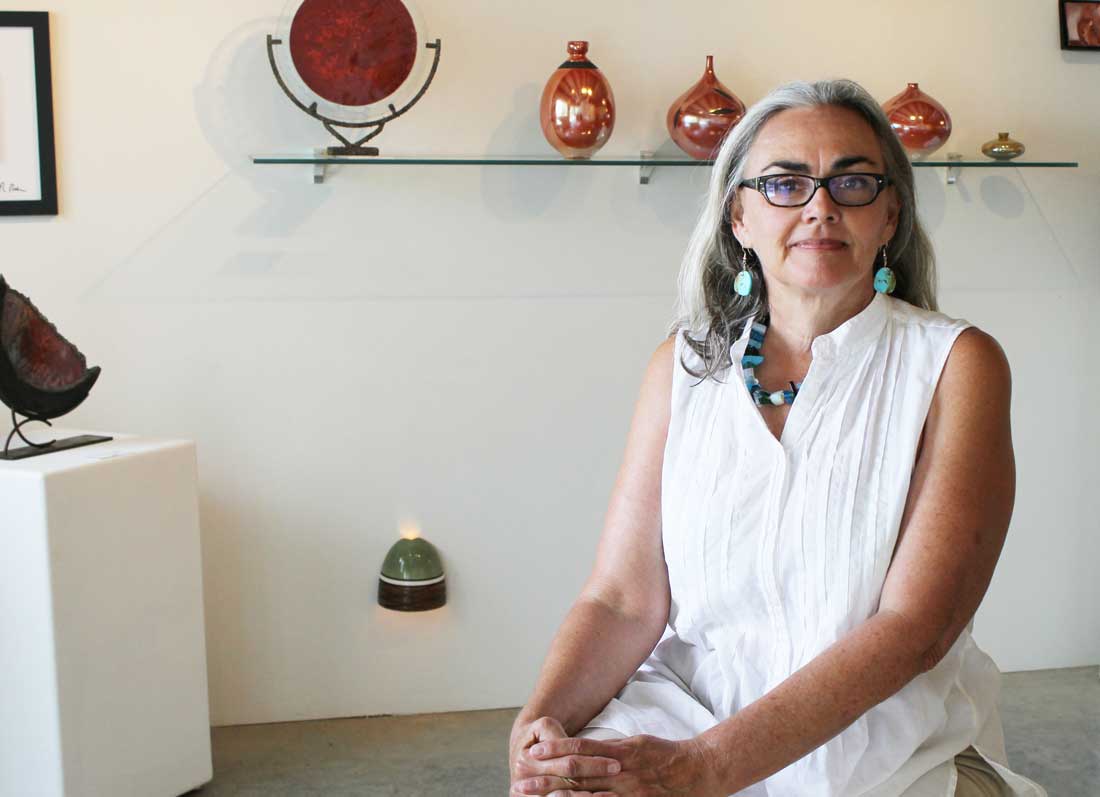With the help of 10 former jail inmates, Fort Worth artist Pamela Summers is getting ready to install a 240-foot mosaic “ribbon” for the city of Grand Prairie. It won’t be her first time working with those who have been through the criminal justice system, but it will be the biggest public art piece of her career.
Summers, whose mosaics can be seen in Fort Worth parks and along the Trinity Trails, is teaming up with participants in Grand Prairie’s Weed-N-Seed job-training program. The group of ex-offenders will install the mosaic that Summers designed along a concrete retaining wall on Northeast 15th Street off I-30.
As part of the program, participants receive tile work training and basic art education. The aim is to “weed” out crime and “seed” in beneficial practices to help ex-offenders gain job skills. Besides tile skills, the nonviolent offenders will learn about bringing an artistic design to life.
“We’re not trying to turn them into artists — we’re trying to turn them into someone who can install art,” said Tammy Chan, special projects manager in the city manager’s office.
Chan has managed the Weed-N-Seed program since 2002. She also works with the public streetscaping coordinator and the Keep Grand Prairie Beautiful program. “I try to merge all three … whenever possible, and this project represents that,” she said.
A $50,000 grant from the National Endowment for the Arts and donations from local sponsors are funding the $185,000 project.
The Grand Prairie Sports Facilities Development Corporation is matching the NEA grant. The corporation, which operates Lone Star Park horse track, promotes city projects that reduce unemployment. Local commercial tiling companies Five Star Flooring and ARDEX Americas hosted grant-funded workshops on grout and mortar and how to prepare the wall for the mosaic. Grant money is also paying for online courses from the University of Ceramic Tile and Stone, in which participants will earn certifications to help them find future jobs.
The Weed-N-Seed re-entry program is about to shrink. In the future, it will be open only to Grand Prairie residents and will serve half as many people per year — about 60 rather than the current 120, said Andy White, assistant to the city manager.
White said no final decisions have been made. Currently, only 25 to 30 percent of participants find full-time work because many don’t have the needed documents, like a state-issued identification card, he said.
“We want to address that up front before we put them into the program,” White said.
Only people with their paperwork in order will be accepted in the future. “We may be slowing down the program on the back end, but the people that we put through the program will be better prepared,” he said.
Though the program is changing, Chan said she believes it will remain effective.
“The vast majority of the participants really just want a chance to show you how hard they will work and how much they’ve changed,” she said. “Most have. Most are the best workers you could ever hope for.”
Program participant Michelle Tilley said that the training has given her more confidence in looking for a job.
“It’s helped me a lot,” she said. “Before I got into the Weed-N-Seed program, I felt like people wouldn’t give me a chance.”
Tilley said she’s always been interested in mosaic artwork and is looking forward to learning how a mosaic comes together.
Summers will lead the next set of workshops, focusing on creating and installing handmade tiles and using digital software to create designs. Participants are also learning art history, color theory, and photography at workshops led by the Association of Grand Prairie Artists.
Beyond specific work skills, Summers said, the mosaic project will give participants a creative edge, which could help them in working with future clients who might want an artistic element in their tile work.
Summers previously taught pottery-making at the federal prison for men in Fort Worth. She said she learns something new every time she teaches.
“I see people’s artistic spirit, how strong it might be,” Summers said “There’s something special about sharing what you love, and I’m fortunate to be able to do that in this entire project.”
Chan, familiar with Summers’ work from attending gallery nights in Fort Worth, sought her out for her distinct style. Pieces that Summers created for the nonprofit Streams and Valleys group are installed in Overton Park and Trinity Park and at the White Settlement trailhead.
Her ceramics and tile pieces reflect themes from nature in an abstract style. She considers herself a contemporary colorist, using shapes, colors, and textures to create visual excitement and a sense of depth.
“We’ve got a ‘Pam Summers’ feel, but then we’ve got these beautiful prairie grass seeds and flowers that are all incorporated into this flowing mosaic,” she said. Thousands of one-inch-square tiles in bright yellows, rich blues, and earthy greens, in a ribbon as wide as six feet, will illustrate the city’s prairie history.
“I decided to use a ribbon because it would take your eye all across the wall,” Summers said. “I see the ribbon as a window into the prairie.”
The mosaic will be the largest design she’s done. “I hope it’s going to take me in a whole new direction with public art and larger projects,” she said.
Chan and Summers spent months brainstorming and trading digital sketches before settling on a design. A company in Boston will transfer the prairie illustration directly to recycled glass tiles.
“This company … has the software ability to take my design and come up with a custom palette,” Summers said. Installation is expected to start in August.
She said she’s excited at the chance to expose the participants to an artist’s point of view and the lasting effects of art.
“It’s one thing installing a bathroom floor. It’s another thing to not only install a work of art but to be a part of creating it,” she said. “I am looking forward to seeing them look at their finished artwork, complete and installed, and see that that’s going to be there for 100 years.”
A ribbon-cutting for the mosaic is planned for early September. Chan said if the project goes well, it could lead to other collaborations with artists to improve the appearance of the I-30 corridor. She would like to continue using tile to carry the prairie theme to other walls along the highway.
“Grand Prairie is very open to the arts,” Chan said “We want to do so much more, and I think this project will help lead us in that direction.”
Melissa Wylie can be reached at melissa-wylie01@gmail.com.













This is very interesting. What an excellent program!